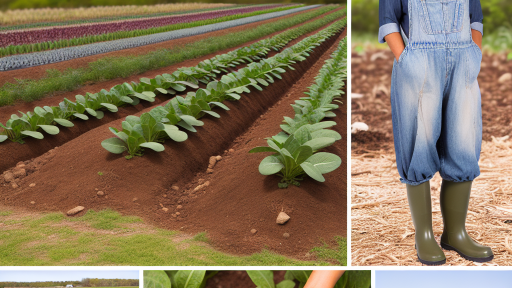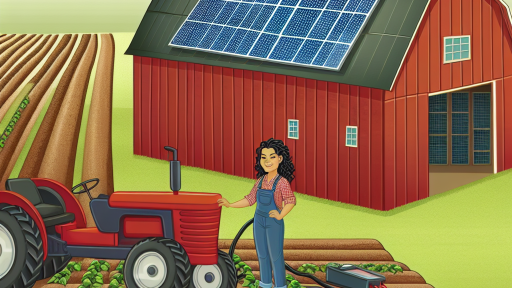Introduction to Carbon Sequestration in Agriculture
Carbon sequestration plays a vital role in sustainable agriculture.
This process involves capturing and storing atmospheric carbon dioxide.
Farmers can actively contribute to curbing climate change through effective practices.
Moreover, these practices can also enhance farm profitability.
Understanding Carbon Sequestration
Carbon sequestration refers to the long-term storage of carbon in soil and plants.
Farmers use various techniques to achieve this, including cover cropping and agroforestry.
Through these methods, farmers can significantly increase soil organic matter.
As a result, this enriches soil health and boosts crop yields.
The Role of Soil Health
Healthy soil acts as a carbon sink, absorbing more carbon than it releases.
It also retains moisture and nutrients better than degraded soil.
Consequently, improved soil health translates into increased agricultural productivity.
Farmers can therefore see a direct benefit to their profits.
Implementing Carbon Sequestration Practices
Farmers can adopt several strategies to enhance carbon sequestration.
These practices include crop rotation, reduced tillage, and organic farming.
Each method has distinct advantages tailored to different farming systems.
Transform Your Agribusiness
Unlock your farm's potential with expert advice tailored to your needs. Get actionable steps that drive real results.
Get StartedCrop Rotation
Crop rotation helps to improve soil structure and fertility.
By alternating crops, farmers can disrupt pest cycles and increase biodiversity.
This approach enhances carbon storage in the soil while maximizing yields.
Reduced Tillage
Reduced tillage minimizes soil disturbance, maintaining its carbon stores.
This practice also reduces erosion and promotes healthier root systems.
Farmers can achieve significant cost savings on energy and labor through reduced tillage.
Organic Farming
Organic farming emphasizes sustainable practices that enhance soil health.
This method often leads to increased soil organic matter over time.
Subsequently, organic farms may improve their marketability and price premiums.
Financial Benefits of Carbon Sequestration
Increasing carbon sequestration on farms can lead to higher profits.
Sustainable practices often lower production costs and increase resilience.
Farmers may also benefit from government incentives and carbon credit markets.
Government Incentives
Many regions offer financial incentives for carbon sequestration initiatives.
These incentives can help offset the costs of implementing sustainable practices.
Farmers who participate in these programs may realize substantial economic benefits.
Carbon Credit Markets
Carbon credit markets reward farmers for reducing greenhouse gas emissions.
This creates an additional revenue stream for participating farmers.
Consequently, carbon credits can enhance overall farm profitability.
Outline of Key Practices and Benefits
Carbon sequestration offers both environmental and economic advantages.
By implementing effective practices, farmers can enhance soil health and productivity.
Simultaneously, they can increase their profits and contribute to climate solutions.
Overview of Carbon Sequestration Practices on Farms
Understanding Carbon Sequestration
Carbon sequestration involves capturing and storing atmospheric carbon dioxide.
This process helps mitigate climate change by reducing greenhouse gas levels.
Farmers can adopt various practices to enhance carbon storage in their soil.
Showcase Your Farming Business
Publish your professional farming services profile on our blog for a one-time fee of $200 and reach a dedicated audience of farmers and agribusiness owners.
Publish Your ProfilePractices for Carbon Sequestration
Many carbon sequestration techniques exist that farmers can implement effectively.
No-till agriculture preserves soil structure and improves carbon retention.
Cover cropping enhances soil health and prevents erosion during off-season months.
Agroforestry systems integrate trees with crops and livestock, improving biodiversity.
Crop rotation enriches soil nutrients and fosters a diverse ecosystem.
Benefits of Carbon Sequestration for Farmers
Adopting these practices can lead to improved soil quality over time.
Farmers experience enhanced resilience against extreme weather patterns.
Additionally, these practices often result in higher crop yields and profitability.
Financial Incentives for Farmers
Various programs offer financial incentives for farmers practicing carbon sequestration.
Government initiatives provide funding and grants to support these efforts.
Carbon credit markets allow farmers to sell credits generated from increased sequestration.
Challenges and Considerations
Implementing carbon sequestration practices can present some challenges.
Farmers may need to invest time and resources for these transitions.
Additionally, understanding local regulations on carbon markets is essential.
Examples of Successful Implementation
Farmers like Sophie Caldwell in Iowa have successfully integrated cover crops.
Her farm has seen increased yields and improved soil health over the years.
Similarly, Green Acres Farm utilized agroforestry to enhance ecosystem services.
Their operational costs decreased while biodiversity flourished on the farm.
Economic Benefits of Carbon Sequestration for Farmers
Enhancing Soil Quality
Carbon sequestration improves soil health significantly.
It increases organic matter content in the soil.
Healthy soil supports better crop yields.
Moreover, it enhances water retention abilities in the soil.
This means reduced irrigation costs for farmers.
Generating Additional Revenue Streams
Farmers can participate in carbon credit markets.
This allows them to sell carbon credits for sequestration.
Additionally, farmers can take advantage of government incentives.
These programs reward practices that promote carbon storage.
Consequently, farmers can diversify their income sources.
Cost Savings Through Sustainable Practices
Adopting carbon sequestration practices can decrease costs.
For example, reduced fertilizer use can lead to savings.
Cover cropping helps suppress weeds, lowering chemical costs.
Furthermore, improved soil health lowers erosion and restoration costs.
All these practices collectively contribute to increased profitability.
Long-Term Investment in Farming
Carbon sequestration represents a sustainable farming approach.
By investing in these practices, farmers protect their land.
Long-term benefits include enhanced resilience to climate change.
This resilience ensures consistent production over the years.
In the end, this leads to greater financial security for farmers.
Find Out More: Implementing Biochar in Agriculture for Carbon Storage
Impact of Carbon Credits and Market Opportunities
Understanding Carbon Credits
Carbon credits represent a certification for greenhouse gas reductions.
Showcase Your Farming Business
Publish your professional farming services profile on our blog for a one-time fee of $200 and reach a dedicated audience of farmers and agribusiness owners.
Publish Your ProfileFarmers can earn credits by practicing carbon sequestration.
Moreover, these credits can be sold on various markets.
This creates an additional income stream for agricultural producers.
Market Opportunities for Farmers
The demand for carbon credits is growing rapidly.
Businesses seek credits to offset their carbon emissions.
As a result, the market value of credits is increasing.
This shift opens new avenues for farmers to generate revenue.
Types of Sequestration Practices
Farmers implement various practices to sequester carbon effectively.
Cover cropping enhances soil health and captures carbon.
No-till farming reduces soil disturbance and promotes carbon storage.
Additionally, agroforestry integrates trees into farmlands, boosting sequestration.
These methods not only improve farm profitability but also enhance sustainability.
Evaluating Financial Benefits
The financial returns from carbon credits can be significant.
For instance, participating in carbon markets can add thousands to farm profits.
Moreover, increased soil health often results in higher yields.
Farmers can benefit from reduced input costs through healthier soils.
Challenges and Considerations
Farmers must navigate several challenges related to carbon markets.
Understanding the regulatory landscape is essential.
Record-keeping and monitoring practices can be complex.
Furthermore, market prices can fluctuate based on demand and policy changes.
Future of Carbon Sequestration in Agriculture
The future of carbon sequestration in agriculture appears promising.
As awareness and demand grow, farmers are likely to see more opportunities.
Aligning agricultural practices with carbon strategies can enhance profitability.
In essence, carbon credits contribute to environmental benefits and support farm economics.
Delve into the Subject: Adapting Farming Practices to Changing Water Patterns
Cost-Benefit Analysis: Investment vs. Returns in Carbon Farming
Understanding Carbon Farming Investments
Carbon farming requires upfront investment for long-term benefits.
Farmers need to focus on practices like cover cropping and agroforestry.
These methods improve soil health and sequester carbon.
Cost considerations include seed, equipment, and labor expenses.
Potential funding sources may include government grants and private investments.
Estimating Potential Returns
The returns on carbon farming vary based on several factors.
Carbon credits can provide additional revenue streams.
Farmers can sell these credits to companies aiming to offset emissions.
Long-term agricultural productivity often increases due to enhanced soil health.
Higher crop yields may lead to better profits.
Conducting a Cost-Benefit Analysis
It’s crucial to perform a detailed cost-benefit analysis.
This analysis should include both quantitative and qualitative factors.
Farmers can calculate potential profits against initial investments.
They must consider timeframes for return on investment.
Additionally, evaluating risks associated with climate variability is important.
Showcase Your Farming Business
Publish your professional farming services profile on our blog for a one-time fee of $200 and reach a dedicated audience of farmers and agribusiness owners.
Publish Your ProfileCase Studies of Successful Carbon Farming
Many farmers have successfully adopted carbon farming practices.
One example is Thompson Family Farms in Oregon.
They transitioned to regenerative practices and saw increased carbon credits.
Another success story is Green Fields Co. in Iowa.
They implemented agroforestry and reported improved crop resilience.
Challenges in the Implementation
Farmers face several challenges when adopting carbon farming.
Knowledge gaps regarding specific practices often exist.
Initial costs can be a significant barrier for some farmers.
Additionally, securing carbon credit verification can be complex.
Addressing these barriers requires education and support systems.
Delve into the Subject: Top Farming Methods to Handle Climate Shifts

Regulatory Incentives and Support for Carbon-Sequestering Practices
Understanding Regulatory Frameworks
Governments worldwide are introducing regulatory frameworks to encourage carbon sequestration.
These frameworks aim to reduce carbon emissions and enhance agricultural sustainability.
Farmers can benefit significantly from understanding these regulations.
Financial Incentives for Farmers
Financial incentives play a crucial role in promoting carbon-sequestering practices.
Subsidies and grants can offset the initial costs of implementing sustainable techniques.
For example, the Conservation Stewardship Program offers payments for implementing conservation practices.
Such programs encourage farmers to adopt methods like cover cropping and no-till farming.
Tax Credits and Deductions
Tax credits are another attractive incentive for farmers adopting carbon sequestration practices.
These credits can significantly reduce the cost burden associated with sustainable farming practices.
For instance, some farmers qualify for credits through their carbon-reducing investments.
Government Grants and Support Programs
Various government grants provide financial support for innovative agricultural practices.
The Environmental Quality Incentives Program helps farmers implement conservation projects.
This program often covers a portion of the costs related to soil health improvement.
Role of Non-Governmental Organizations
Non-governmental organizations also play a vital role in supporting carbon sequestration.
They provide resources and technical assistance to farmers navigating new practices.
Moreover, some NGOs facilitate access to markets for carbon credits.
Collaboration with Research Institutions
Collaborating with research institutions offers farmers insights into best practices.
These partnerships can lead to innovative solutions for effective carbon sequestration.
Access to research findings enables farmers to improve yield with sustainable methods.
Significance of Regulatory Support for Farmers
Regulatory incentives and support significantly impact farm profits.
Farmers who utilize these resources enhance their profitability while benefiting the environment.
Understanding and leveraging these incentives paves the way for sustainable agricultural success.
Discover More: Rainwater Harvesting Strategies for Modern Farms
Case Studies: Successful Implementation of Carbon Sequestration on Farms
The Oak Ridge Organic Farm Experience
Oak Ridge Organic Farm adopted carbon sequestration practices in 2020.
Initially, they focused on cover cropping techniques to enhance soil health.
This method improved organic matter levels in their fields significantly.
As a result, they observed a 30% increase in crop yields.
Moreover, their carbon credits revenue helped offset operational costs.
Green Pastures Cattle Ranch
Green Pastures Cattle Ranch implemented rotational grazing strategies.
Showcase Your Farming Business
Publish your professional farming services profile on our blog for a one-time fee of $200 and reach a dedicated audience of farmers and agribusiness owners.
Publish Your ProfileThis practice encourages plant regrowth and increases soil carbon storage.
Consequently, they reported a 20% rise in pasture productivity over two years.
Additionally, their beef production became more sustainable and profitable.
Furthermore, the ranch sold carbon credits, adding to their income.
Sunny Fields Vineyard
Sunny Fields Vineyard integrated agroforestry into their grape production.
This technique involved planting trees alongside vineyard rows.
The trees provided shade and enhanced biodiversity in their ecosystem.
Moreover, the vineyard experienced an increase in grape quality and quantity.
With this approach, they reduced overall irrigation needs significantly.
They also capitalized on carbon credits, boosting their profitability.
Harvest Moon Agroforestry
Harvest Moon Agroforestry focused on soil management techniques.
They used biochar and compost to enhance soil fertility and structure.
This investment resulted in improved nutrient retention and moisture holding.
The farm’s productivity doubled over three years, showcasing effective methods.
Consequently, they achieved greater economic stability and resilience.
Innovative Solutions at Prairie View Farm
Prairie View Farm adopted precision agriculture technologies in their practices.
They utilized data analytics to optimize fertilizer use and water application.
As a result, they reduced input costs while maximizing sequestering outcomes.
This approach improved their environmental footprint and financial returns.
They also engaged in community education about sustainable practices.
Lessons Learned from Successful Farmers
These farmers share invaluable lessons from their experiences.
- Investing in soil health pays long-term dividends.
- Integrating diverse practices can enhance both productivity and sustainability.
- Seeking carbon credit opportunities can provide additional revenue streams.
- Community engagement strengthens awareness and support for sustainable farming.
Embracing innovative practices ensures the viability of modern agriculture.
Future Trends and Innovations in Carbon Sequestration Technologies
Advancements in Soil Carbon Management
Soil health plays a vital role in carbon sequestration.
Farmers adopt new technologies to improve soil organic matter.
This helps capture more carbon from the atmosphere.
Moreover, innovative practices like cover cropping enhance nutrient cycling.
Consequently, these methods also increase overall farm productivity.
Utilization of Enhanced Weathering
Enhanced weathering involves spreading minerals on farmland.
This practice accelerates natural mineral breakdown.
As a result, it captures carbon dioxide effectively.
Furthermore, farmers can leverage locally sourced materials.
This reduces transportation costs and promotes sustainability.
Integration of Agroforestry Practices
Agroforestry combines agriculture with tree planting.
This method enhances biodiversity and carbon storage.
Trees absorb carbon dioxide while providing shade and habitat.
Farmers see multiple benefits from these integrated systems.
For instance, improved soil health boosts crop yields.
Adoption of Carbon Capture Technologies
Carbon capture technologies may soon revolutionize farming.
Farmers could integrate equipment that captures CO2 directly.
These systems can convert captured carbon into useful products.
Showcase Your Farming Business
Publish your professional farming services profile on our blog for a one-time fee of $200 and reach a dedicated audience of farmers and agribusiness owners.
Publish Your ProfileFor example, created biochar improves soil health significantly.
Consequently, this innovation minimizes overall carbon emissions.
Emphasis on Data-Driven Solutions
Data analytics play a critical role in carbon sequestration.
Farmers utilize software to monitor and manage carbon levels.
This allows for more informed decision-making processes.
Moreover, precision farming technologies help optimize practices.
By doing so, farmers can enhance both yield and sustainability.
Additional Resources
Agriculture Working Group | Wisconsin Initiative on Climate Change …
Philanthropic Funding Ignites Promising Carbon Sequestration …




